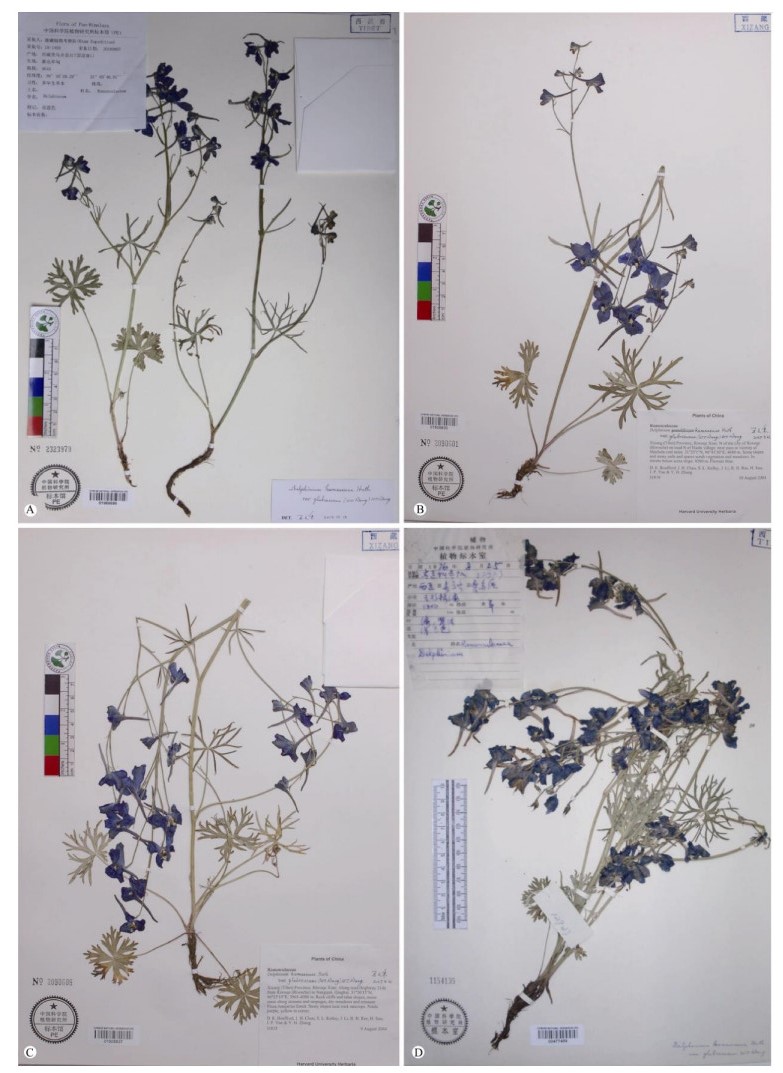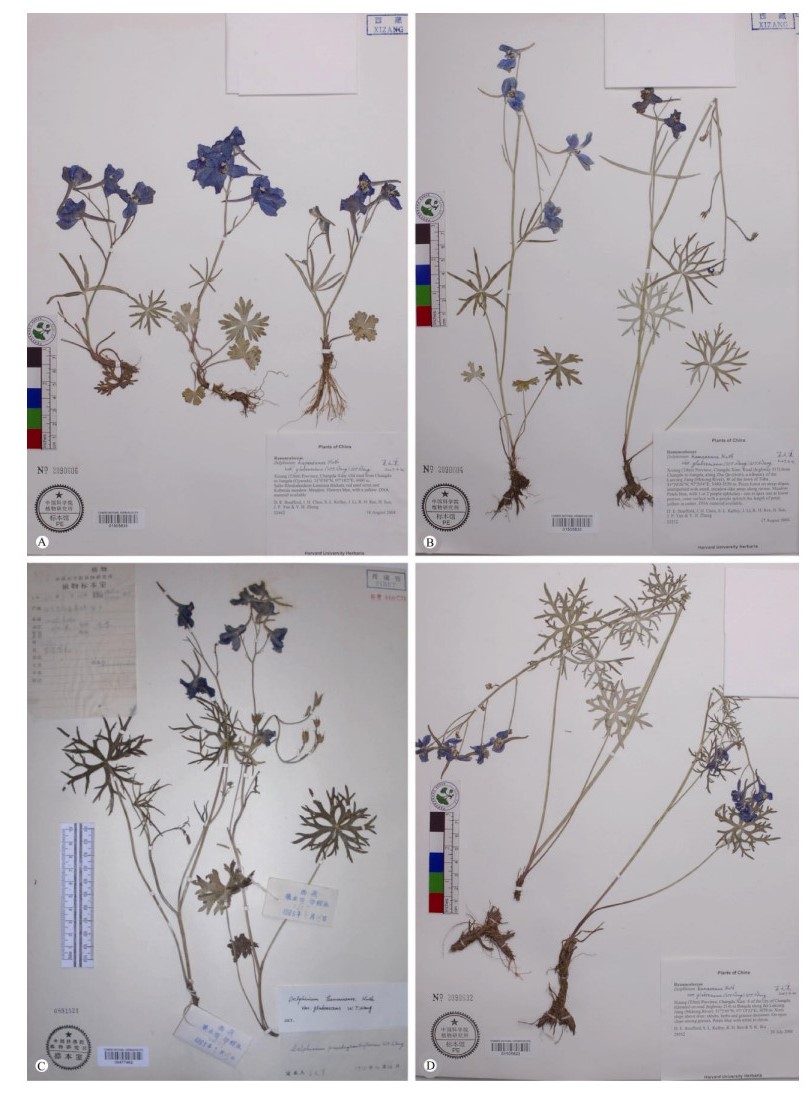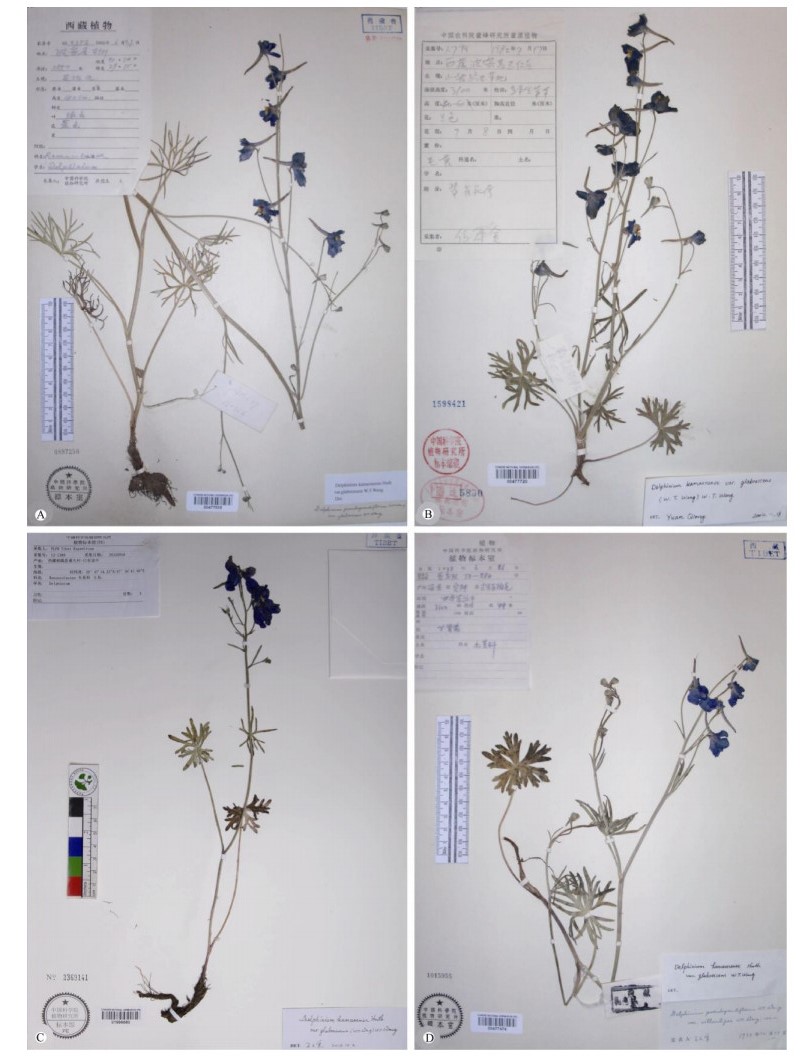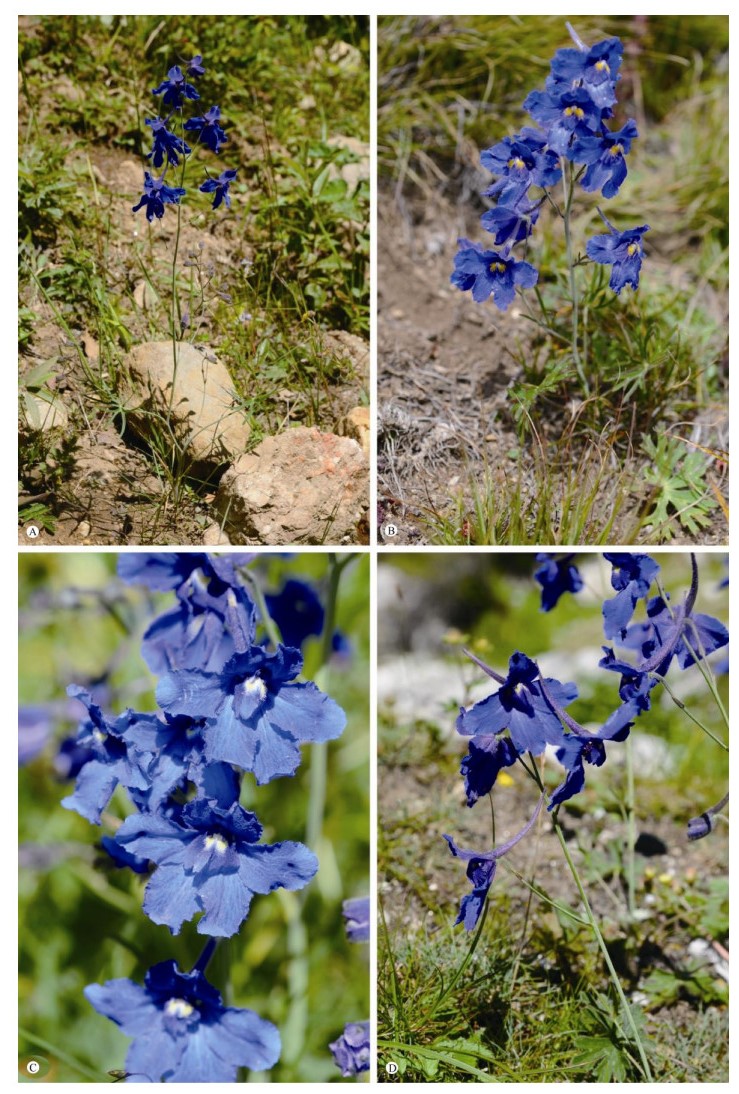The aim of this paper is to clear up a certain amount of confusion about Delphinium kamaonense Huth, a species widely distributed in the Sino-Himalayan region and very common in Gansu, Qinghai, Sichuan and Xizang, China. For the convenience of discussion we will review the problem chronologically.
In 1962, Wang[1] described Delphinium pseudo-grandiflorum W. T. Wang (Ranunculaceae) on the basis of a series of specimens from southeastern Xizang and western Sichuan, China, with X. Li 74016 (PE) from Heishui in western Sichuan designated as the holotype. In the protologue, he stated that D. pseudograndiflorum was most closely similar to D. grandiflorum L., but differed in the very sparsely spreading puberulent stem. In the same paper, he also described D. pseudograndiflorum var. glabrescensW. T. Wang on the basis of two collections from south-eastern Xizang, i.e., G. C. Xia 518 (IDM) from Bomi and G. C. Xia & T. K. Mi 336 (IDM) from Zayu, with the latter designated as the holotype, and stated that it was distinguishable from the type variety, var.pseudograndiflorum, by the glabrous stem and pedicels.
In describing the two taxa just mentioned above, it is evident that Wang was unaware of the occurrence ofD. kamaonense in China, a species which was originally described from Kamaon (Kumaun) in northwestern India (Fig. 1). It was till 1979 that Wang[2] found D. pseudograndiflorum was conspecific with D. kamaonense and thus made the correct treatment of merging them, but he still retained D. pseudograndiflorum var. glabrescens as an independent taxonomic entity, transferring it to D. kamaonense and making the combination D. kamaonense var. glabrescens (W. T. Wang) W. T. Wang.

|
Fig. 1 Type specimens of Delphinium kamaonense. A: J. F. Duthie 2675 (syntype, K), Darma, Kamaon (Kumaun), India; B: J. F. Duthie 2675 (syntype, E). |
In 1979, Wang[3] described Delphinium obcorda-tilimbum W. T. Wang on the basis of a collection, Qinghai-Xizang Veg. Exped. 9213 (Fig. 2), from Riwoqe, southeastern Xizang, China. He compared it with D. majus (W. T. Wang) W. T. Wang from north-western Yunnan, stating that D. obcordatilimbum was different from that species by the leaves tripartite to 4 mm from the base, the glabrous inflorescence axis, the distally sparsely puberulent pedicels, and the obcordate staminode limbs.

|
Fig. 2 Specimens of Delphinium kamaonense. A: Qinghai-Xizang Veg. Exped. 9213 (holotype ofD. obcordatilimbum, PE), Riwoqe, Xizang, China; B: Qinghai-Xizang Veg. Exped. 9213 (isotype ofD. obcordatilimbum, PE). |
Based on a survey of ample herbarium material, we found that Delphinium kamaonense is widely distributed in China (Gansu, Qinghai, western Sichuan, Xizang), with the distribution being nearly continuous. In our field work, we found that in the Qinghai-Xizang Plateau, the species is a very common, nearly weedy plant. It is easily recognizable by the stem usually densely spreading white puberulent in the lower part, sparsely spreading white puberulent or glabrous in the median and upper parts; pedicels more or less densely puberulent distally but glabrous or sparsely spreading white puberulent elsewhere; basal and median leaves often 3-fid or 3-parted with the segments cuneate or narrower, these laciniate into oblong or linear lobules; upper leaves finely dissected into linear lobules; flowers usually deep blue; spur of the upper sepal cylindrical-subulate, straight or slightly upcurved (Figs. 1-6). It is noteworthy that in the genus Delphinium L., just as in its close ally Aconitum L., the pedicel pubescence is one of the most stable and thus most reliable taxonomic characters at specific level (or, in some cases, at infraspecific level), whereas the stem pubescence is often highly variable between and within populations of a given taxon.

|
Fig. 3 Specimens of Delphinium kamaonense, all from Riwoqe, Xizang, China, the type locality of D. obcordatilimbum. A: Kham Exped.10-1460 (PE); B: D. E. Boufford et al. 31979 (PE); C: D. E. Boufford et al. 31833 (PE); D: Qinghai-Xizang Exped. 12923 (PE). |

|
Fig. 4 Specimens of Delphinium kamaonense, all from Qamdo, Xizang, China. A: D. E. Boufford et al. 32462 (PE); B: D. E. Boufford et al. 32532 (PE); C: Y. T. Chang & K. Y. Lang 2815 (PE); D: D. E. Boufford et al. 29552 (PE). |

|
Fig. 5 Specimens of Delphinium kamaonense, respectively from Bomi [A, B; paratype locality of D. kamaonense var.glabrescensW. T. Wang (W. T. Wang)] and Zayu (C, D; holotype locality of D. kamaonense var.glabrescens), Xizang, China. A: T. S. Ying & D.Y. Hong 650356 (PE); B: Z. J. Ren 799 (PE); C: FLPH Tibet Exped. 12-1388 (PE); D: Qinghai-Xizang Exped. 73-280 (PE). |

|
Fig. 6 Delphinium kamaonense in the wild. A, B: Habitat and habit; C, D: Portion of inflorescence. Photos by Y. S. Chen from Cona (A, D), Nyalam (B) and Qamdo (C), Xizang, China. |
Careful comparison of the type specimens of Delphinium kamaonense var. glabrescens and D. obcordatilimbum with the rich materialof D. kamaonense from China has convinced us that the three names encompass only one taxonomic entity. The former two taxa totally fall within the range of morphological variation of the latter and thus are not worthy of recognition. During our botanical expedition to Xizang in 2005, we found that D. kamaonense is very common in Riwoqe, the type locality of D. obcordatilimbum. It is far from understandable to us that in describing D. obcor-datilimbum Wang[3] has bothered to contrast it with D. majus from northwestern Yunnan, but not conveniently with D. kamaonense, which is such a common plant in Xizang. In our opinion, D. majus itself is not a well-established species and its identity needs further verification; it is very closely similar to or most likely even conspecific with D. tatsienense Franch., a species widely distributed in western Sichuan and central and northern Yunnan. It is also very difficult to distinguish D. majusfrom D. mosoynense Franch., which is common in northwestern Yunnan.
Based on the above analyses we consider it justifiable to reduce both Delphinium kamaonense var. glabrescens and D. obcordatilimbum to the synonymy of D. kamaonense.
Taxonomic treatmentDelphinium kamaonense Huth in Bull. Herb. Boiss. 1: 333.1893; Munz in J. Arn. Arb.48: 521. 1967; W. T. Wang in Fl. Reipubl. Popularis Sin. 27: 448. 1979; et in Fl. Xizang. 2: 56. 1985; W. T. Wang & Warnock in Fl. China 6: 269. 2001. Type: India: Kamaon (Kumaun), Nipshany Valley in Darma, 4300-4600 m, Aug. 31, 1884, J. F. Duthie 2675 (syntypes, probably G, E!; K!).
D. sordidecaerulescens Ulbr. in Notizbl. Bot. Gart. Berl. 12: 358. 1935; Munz in J. Arn. Arb. 48: 534. 1967.---D. tatsienense f. sordidecaerulescens (Ulbr.) Hand.-Mazz. in Acta. Hort. Gothob. 13: 61. 1939. Type: China. Sichuan: reg. bor. Huang-chen-kuan, in prato, 3400 m, H. Smith 3983 (holotype, UPS).
D. pseudograndiflorum W. T. Wang in Acta Bot. Sin. 10: 275. 1962; Munz in J. Arn. Arb. 48: 530. 1967, p. p.. Type: China. Sichuan: Heishui, grassland at mountain top, 3300 m, Aug. 16, 1957, X. Li 74016 (holotype, PE!; isotypes, NAS!, SZ!).
D. pseudograndiflorum var. glabrescens W. T. Wang in Acta Bot. Sin. 10: 275. 1962.--D. kamao-nense var. glabrescens (W. T. Wang) W. T. Wang in Fl. Reipubl. Popularis Sin. 27: 449. 1979; et in Fl. Xizang. 2: 58. 1985; et in Vas. Pl. Hengduan Mount. 1: 492. 1993; L. H. Zhou in Fl. Qinghai. 1: 316. 1997; W. T. Wang & Warnock in Fl. China 6: 269. 2001. syn. nov. Type: China. Xizang: Zayu, G. C. Xia & K. T. Mi 336 (holotype, IDM!).
D. pseudograndiflorum var. lobatum W. T. Wang in Acta Bot. Sin. 10: 275.1962. Type: China. Xizang: Qamdo, Aug. 11, 1951, Y. W. Tsui 5224 (holotype, PE!).
D. obcordatilimbum W. T. Wang in Fl. Reipubl. Popularis Sin. 27: 616. 1979; et in Fl. Xizang. 2: 56. 1985; Wang & Warnock in Fl. China 6: 267. 2001. syn. nov. Type: China. Xizang: Riwoqe, 3850 m, Jul. 21, 1976, Qinghai-Xizang Veg. Exped. 9213 (holotype, PE!; isotype, PE!).
Additional specimens examined.Gansu: Jone, W. Y. Hsia 8381 (WUK), T. P. Wang 5572 (PE, WUK); Luqu, Tao River Exped. 427 (KUN), Xiahe, K. T. Fu 1486 (IBSC, PE, WUK), Tao River Exped. 041 (KUN), Q. R. Wang & M. S. Yan 10643 (PE), 10738 (PE); Tao River basin, J. F. Rock 13178 (NAS, PE), 14594 (NAS). Qinghai: Chindu, Anonymous 726 (PE), S. W. Liu 00494 (PE), 2463 (HNWP), Q. E. Yang & Q. Yuan 419 (PE); Henan, S. W. Liu 1934 (HNWP); Jigzhi, D. E. Boufford et al. 39466 (PE), Xizang Med. Pl. Exped. 632 (HNWP); Maqen, T. N. Ho et al. 437, Y. H. Wu 4633 (HNWP); Nangqen, P. C. Kuo & W. Y. Wang 8385 (HNWP), Xizang Med. Pl. Exped. 1038 (HNWP, PE), 1188 (PE), Y. C. Yang 1189 (HNWP, PE, WUK), Z. D. Wei 21913 (HNWP), 22089 (HNWP); Tongde, Y. H. Wu 5372 (HNWP); Tongren, P. C. Kuo 25892 (HNWP), S. W. Liu 3561 (HNWP), Q. E. Yang 9516 (PE); Yushu, Anonymous 388 (HNWP, PE, WUK), T. N. Ho et al. 1972 (PE), 2044 (PE), B. Ren 014 (PE), 033 (PE), Q. E. Yang & Q. Yuan 428 (PE), 431 (PE); Zhidoi, T. N. Ho et al. 1720 (PE). Sichuan: Aba, D. E. Boufford et al. 39432 (PE), X. Li 72042 (IBSC, NAS, PE); Baiyu, D. E. Boufford et al. 37004 (PE), H. Y. Li 139 (PE), Z. X. Tang et al. 770 (PE), H. S. Ye s.n. (PE); Barkam, X. Li 71757 (IBSC, NAS, PE), 72254 (IBSC, NAS, PE), Sichuan Med. Pl. Resour. Exped. 22806 (NAS), Sichuan Veg. Exped. 9528 (CDBI, IBSC, PE); Batang, Anonymous 1545 (PE), 1667 (PE), D. E. Boufford 35550 (PE), K. Y. Lang et al 2392 (KUN, PE), K. Yao 891 (NAS); Dawu, Anonymous 5689 (CDBI, PE), 5789 (PE), 5871 (CDBI, PE), W. K. Hu & Z. He 10877 (PE), 10905 (PE), S. Jiang et al. 9601 (PE), Sichuan Med. Pl. Resour. Exped. 15758 (NAS); Dege, D. E. Boufford et al. 36400 (PE), 36421 (PE), 36700 (PE), S. X. Jia s.n. (PE), 133 (PE), Sichuan Veg. Exped. 7345 (PE), Z. X. Tang et al. 609 (PE), Y. W. Tsui 5030 (PE); Derong, X. W. Tian 095 (PE); Garze, D. E. Boufford 36332 PE), W. K. Hu 13106 (PE), S. Jiang et al. 9601 (PE), Sichuan Med. Pl. Resour. Exped. 15145 (NAS), Y. W. Tsui 4942 (PE), T. S. Ying 4545 (PE); Heishui, X. Li 73446 (PE), 73654 (IBSC, NAS, PE); Hongyuan, Anonymous 23636 (NAS, PE), D. E. Boufford et al. 40023 (PE), 40051 (PE), X. Li 2153 (NAS, PE), 72086 (IBSC, NAS, PE), 72101 (IBSC, PE), B. C. Ni 00284 (CDBI), Sichuan Med. Pl. Resour. Exped. 20655 (NAS), Y. C. Tang et al. 20 (NAS, PE), Z. X. Tang 1710 (PE), 1778 (PE), Q. E. Yang & Q. Yuan 307 (PE), 310 (PE), K. Yao 610 (NAS), Q. S. Zhao 0261 (P, PE); Kangding, W. K. Hu 13106 (PE), J. A. Soulié 2389 (P), 2389a (P), Q. E. Yang & Q. Yuan 260 (PE); Litang, D. E. Boufford et al. 42258 (PE), Hengduan Shan Veg. Exped. 4954 (PE), Lixian, Anonymous 33576 (PE), D. P. He 45697 (HNWP, WUK), 45823 (HNWP, IBSC, WUK), E. L. Liu 9 (PE), Y. Luo 328 (PE), 331 (PE), Q. S. Zhao 1241 (PE); Luhuo, D. E. Boufford 33496 (PE), 34250 (PE), 34743 (PE); Nanping, Sichuan Econ. Pl. Exped. 4114 (CDBI), Q. E. Yang 92020 (PE); Pingwu, L. M. Lu 2008355 (PE); Sertar, D. E. Boufford et al. 34568 (PE), J. H. Feng 06708 (CDBI, PE); Serxu, X. H. Hu 28363 (CDBI); Songpan, Anonymous 9528 (CDBI), Sichuan Econ. Pl. Exped. 4114 (CDBI), X. N. Tang 01013 (CDBI), 00758 (CDBI), Q. E. Yang & Q. Yuan 310 (PE), Y. B. Yang 0758 (CDBI); Tianquan, H. L. Tsiang 173 (IBSC, NAS, PE); Xiaojin, S. S. Chang & Y. X. Ren 6039 (PE), 6259 (CDBI), 6462 (CDBI, PE), Q. E. Yang & Q. Yuan 292 (PE), 296 (PE); Xinlong, Q. W. Meng & H. Y. Xie s.n. (PE); Zamtang, D. E. Boufford et al. 38916 (PE), 39038 (PE), 39084 (PE); Zoige, Anonymous 10276 (PE), D. E. Boufford 39954 (PE), G. C. Chen et al. 1331 (HNWP), X. Q. Li 0317 (CDBI), Sichuan Med. Pl. Resour. Exped. 20104 (NAS), 20395 (NAS), D. H. Zhu et al. 4604 (PE), 4628 (PE). Xizang: Baqen, D. E. Boufford et al. 29985 (PE), D. D. Tao 11076 (KUN, PE); Baxoi, Anonymous 929 (PE), D. E. Boufford 29694 (PE), C. C. Ni et al. 1255 (PE), Qinghai-Xizang Exped. 73-1166 (PE), Z. J. Ren s.n. (PE); Bomi, Anonymous 518 (KUN), Biol. Inst. Xizang Exped. 685 (HNWP), 710 (HNWP), Y. T. Chang & K. Y. Lang 323 (PE), 328 (PE), 463 (PE), Qinghai-Xizang Exped. 73-126 (KUN, PE), Z. J. Ren 799 (PE), L. Xie BM11 (PE), T. S. Ying & D. Y. Hong 650356 (PE), 651114 (PE), J. W. Zhang 1735 (PE); Burang, Biol. Inst. Xizang Exped. 3889 (HNWP), 4038 (HNWP, PE), FLPH Tibet Exped. 12-0099 (PE), Qinghai-Xizang Exped. 13009 (PE), 13279 (PE), 76-116 (PE), 76-8240 (PE), 76-8488 (PE); Chagyab, Qinghai-Xizang Exped. 12340 (PE), 13003 (PE); Cona, Y. S. Chen et al. 13-0913 (PE), P. C. Kuo & W. Y. Wang 22822 (NAS), Qinghai-Xizang Veg. Exped. 2359 (PE), Suppl. Qinghai-Xizang Exped. 751714 (KUN, PE), 751795 (KUN, PE); Dengqen, J. S. Yang 91 (PE), 91-823 (KUN, PE); Gongbo'gyamda, Y. T. Chang & K. Y. Lang 2745 (PE), Qinghai-Xizang Exped. 7761 (PE), Q. E. Yang & Q. Yuan 503 (PE), 506 (PE), J. S. Yang 89-058 (IBSC, KUN), 89-059 (PE), 90-314 (PE), 90-642 (IBSC, KUN); Gyirong, Y. S. Chen et al. 288 (PE), S. Jiang et al. 283 (PE), B. S. Li et al. 13441 (PE), C. C. Ni et al. 2272 (PE), Qinghai-Xizang Exped. 5626 (PE), 5709 (PE), 7041 (PE), 7084 (PE), 7180 (PE), Xizang Med. Pl. Exped. 679 (PE); Jomda, D. E. Boufford et al. 31231 (PE), 31258 (PE), 31578 (PE), 33840 (PE), Qinghai-Xizang Exped. 12486 (PE), Y. W. Tsui 5289 (PE), Q. E. Yang & Q. Yuan 463 (PE), 467 (PE); Lhorong, Qinghai-Xizang Exped. 8968 (PE); Lhozhag, Y. S. Chen et al. 13-1549 (PE), Mainling, Qinghai-Xizang Exped. 74-3725 (PE), 74-4629 (PE); Markam, Qinghai-Xizang Exped. 005226 (CDBI, KUN, PE); Nagarze, Qinghai-Xizang Exped. 7694 (PE); Nyalam, FLPH Tibet Exped. 12-0371 (PE), Xizang Med. Plant Exped. 1685 (HNWP, PE), 1688 (PE); Nyingchi, Anonymous 2193 (PE), 2367 (KUN), Y. T. Chang & K. Y. Lang 1223 (PE), 953 (PE), J. Luo et al. ML093 (PE), Suppl. Qinghai-Xizang Exped. 751277 (KUN, PE), Xizang Med. Pl. Exped. 3541 (HNWP, PE), C. Y. Wu et al. 75-1190 (KUN); Qamdo, Biol. Inst. Xizang Exped. 1964 (HNWP), 2255 (HNWP), Y. T. Chang & K. Y. Lang 2815 (PE), D. E. Boufford et al. 29552 (PE), 32462 (PE), 32532 (PE), Qinghai-Xizang Exped. 12619 (PE), 12636 (PE), 73-84 (KUN, PE), Q. E. Yang & Q. Yuan 475 (PE), X. Y. Zhu & Y. F. Du 20085 (PE); Riwoqe, D. E. Boufford et al. 31833 (PE), 31979 (PE), 40990 (PE), Kham Exped. 10-1460 (PE), Qinghai-Xizang Exped. 12909 (PE), 12923 (PE), Q. E. Yang & Q. Yuan 478 (PE), 479 (PE); Sog, D. D. Tao 10913 (KUN, PE), 10930 (KUN, PE); Zayu, Biol. Inst. Xizang Exped. 1237 (HNWP), 1320 (HNWP), FLPH Tibet Exped. 12-1388 (PE), R. F. Huang 480 (HNWP), X. H. Jin et al. ST2435 (PE), ST2454 (PE), ST2539 (PE), ST2562 (PE), B. S. Li et al. 07233 (PE), C. C. Ni et al. 1030 (PE), Qinghai-Xizang Exped. 73-280 (PE), J. W. Zhang 1737 (PE); Zogang, Anonymous 76-59 (PE), 76-591 (PE), Qinghai-Xizang Exped. 11005 (PE), 12909 (KUN).
Notes. From a morphological perspective, the closest ally of Delphinium kamaonense may be D. yuanum Chen, a species quite common in northwestern Yunnan and also occurring in the adjacent southwestern Sichuan (Daocheng, Xiangcheng) and southeastern Xizang (Zayu)[4]. Delphinium yuanum is different from D. kamaonense mainly in the glabrous stem, inflore-scence axis and pedicels. These two species seem to be vicarious geographically.
Distribution and habitat. Delphinium kamaonense is distributed in China (Gansu, Qinghai, Sichuan, Xizang; Fig. 7), northwestern India and Nepal. It grows on grassy slopes or in meadows at altitudes of 2500-4600 m.

|
Fig. 7 Distribution ofDelphinium kamaonense in China (●). |
| [1] | WANG W T. Kriticeskij obzor roda Delphinium iz ljutikovych flory kitaja[J]. Acta Bot Sin, 1962, 10(3): 264-284. |
| [2] | WANG W T. Delphinium L.[M]//Flora Reipublicae Popularis Sinicae, Tomus 27. Beijing:Science Press, 1979:326-462. (in Chinese) |
| [3] | WANG W T. Delphinium L. Addenda[M]//Flora Reipublicae Popularis Sinicae, Tomus 27. Beijing:Science Press, 1979:603-621. (in Chinese) |
| [4] | YUAN Q, YANG Q E. Taxonomic studies on the genus Delphinium (Ranunculaceae) from China (Ⅶ):The identity of D. yanwaense[J]. Trop Subtrop J Bot, 2015, 23(5): 479-491. DOI:10.11926/j.issn.1005-3395.2015.05.001 |
 2017, Vol. 25
2017, Vol. 25


